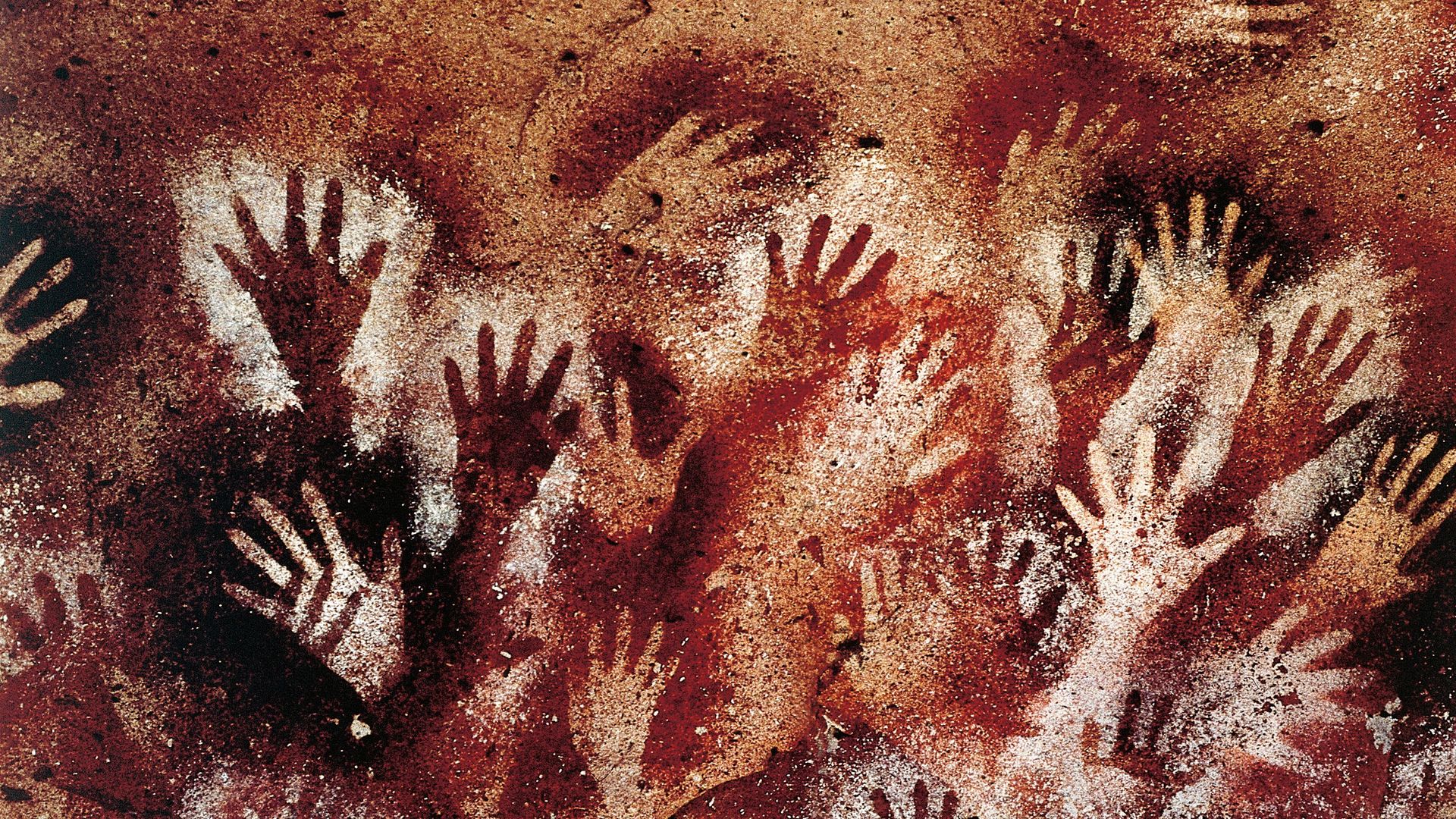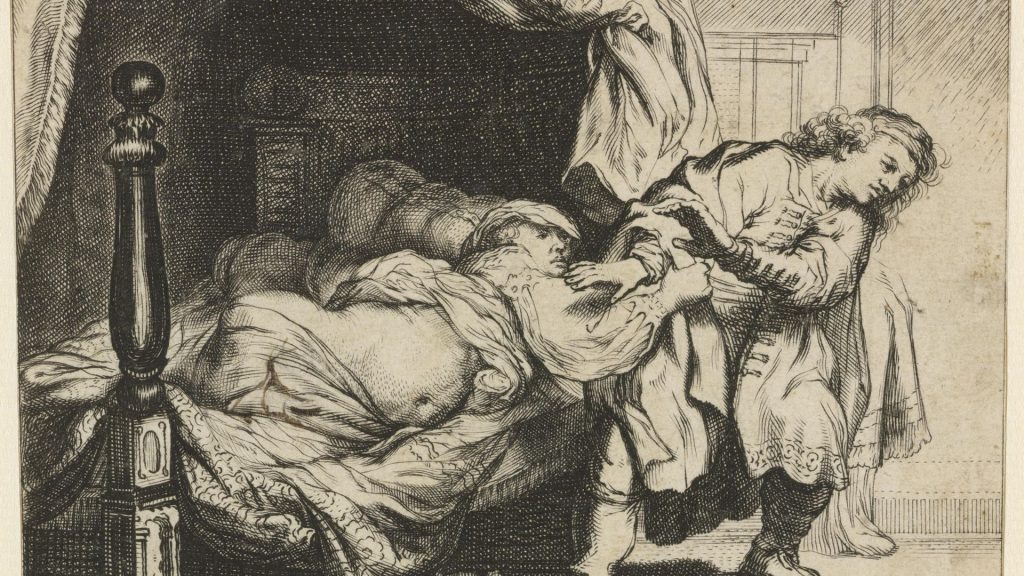
FLORENCE HALLETT reports on a new exhibition with a remarkably topical theme – the totemic importance of touch in art and the human condition.
From the wall of the Cueva de Las Manos – a cave in Santa Cruz, southern Argentina – handprints reach out to us across the millennia. At 9,000-13,000 years old, they are by no means the oldest examples of their kind: last month archaeologists discovered handprints in Indonesia, alongside a life-size painting of a pig, thought to be at least 45,500 years old, and now the oldest known example of representational art.
Made by mixing pigment with saliva and blowing it through a pipe, or directly from the mouth, around a hand placed against the cave wall, these prints are far from accidental. Today, they feel strangely alive with the touch of the people who made them: they remind us that at its most basic level, a work of art is a record of touch, and that our ancient ancestors were curious, creative beings who shared our own instincts to leave a trace.
Ancient handprints find a contemporary echo in Richard Long’s Mud Hand (2016), which serves as a simultaneous declaration of both human and individual identity. Long is one of Britain’s most prominent conceptual artists, and like his famous work A Line Made By Walking (1967), his handprints are mark-making at its purest, his body the instrument, the earth his material.
An exhibition at the Fitzwilliam Museum in Cambridge, postponed due to Covid but ready to open as soon as restrictions ease, takes a similarly expansive view, amounting to a comprehensive account of the intersection between material and social culture.

The Human Touch: Making Art, Leaving Traces examines touch in all its aspects, from its physiological mechanisms, to the many ways in which humans leave their mark, motivated by creativity or faith, as much as the desire to possess or destroy. Touch is explored as our principle means of understanding not only our relationship to others and the world around us, but as part of a perceptual mechanism that affords us a detailed awareness of our own body, inside and out.
The timing of the exhibition feels particularly well-judged, coming after a year in which we have had to radically reconfigure our relationship with our first sense. Touch has become something to avoid, to sanitise, glove and guard against.
At the same time, the notion of ‘skin hunger’ has come into common usage, to describe the emotional and psychological damage suffered by people who are deprived of the touch of others long term.
But touch is not only at the heart of our exchanges with those we love: until now, shaking hands has been ubiquitous between colleagues and acquaintances new and old, an expression of trust and good intention, peace and friendship, that is echoed in expressions like “keeping in touch” and “losing touch”.
Such things were beyond question when curators Elenor Ling and Suzanne Reynolds began working on The Human Touch five years ago, as a multi-disciplinary collaboration between the museums of the University of Cambridge. Perhaps surprisingly, Reynolds explains that aside from aspects of the exhibition’s design, very little changed in response to the pandemic.

“We didn’t bring in any new objects at all, but some of them became even more resonant and powerful given the context, and I suppose that’s another way of saying that what we were trying to show is how fundamental touch is, and now we know what we lose when we don’t have it. We wanted to tell a story about how central touch is to human experience, and the traces of touch on art objects, and the pandemic just made it all more urgent and intense.”
In recent years, the primacy of touch has been challenged from other quarters, and principally by computers. Since the 1980s, artificial intelligence has sought to reproduce manual dexterity and sensitivity, and today haptic technologies are used in medicine and dentistry, video games and virtual reality, including virtual sex.
At the same time, the curators explain in the exhibition catalogue, “’MeToo’ has made visible as never before the interconnectedness of unwanted intimate touch and inequitable power structures; the use of targeted, violent touch as an instrument of oppression and degradation has been laid bare by ‘Black Lives Matter’”.
The reach of the exhibition’s theme is reflected in the array of objects on display, which range from a fragment of an ancient Egyptian coffin with ancient fingerprints preserved in its painted decoration, to examples of the Black Power Fist.
Most of the objects included are from the Fitzwilliam Museum itself, but loans from elsewhere present a new angle on familiar objects. Suzanne Reynolds explains: “Within the museum collections we have quite a traditional display which is chronologically and geographically grouped, but because of the thematic approach of the exhibition we’ve got a baroque bronze next to an ancient Egyptian limestone, for example – we’ve been able to make juxtapositions that shed new light on the objects.”
A considerable portion of the exhibition focuses on hands. Highly sensitive and capable of finely controlled manipulations, they, along with our capacity for reason, mark us out as unique among animals.
Drawing is just one of the many feats of which the human hand is capable, and for artists the study of the hand can be poignantly self-reflexive, with the drawing hand engaged in a meditative dialogue with the observed hand. The anatomical complexity of the hand has long established it as a particular test of skill, important to master as carriers of expression and narrative meaning.
An increased emphasis was placed on the study of anatomy in the Renaissance and Leonardo da Vinci is known to have carried out his own dissections, his work as an artist continuous with and often inseparable from his scientific studies.
Most artists studied anatomy with the aid of plaster casts and artists’ manuals, and Rembrandt’s collection of casts of hands is said to have extended well into double figures. Drawing manuals like Abraham Bloemaert’s (Artful) Drawing Book, published 1650-56, provided examples of hands in various poses and actions that could be copied and reused, and numerous studies of hands by artists including the 16th century Bolognese master Agostino Carracci and Jean-Louis-Ernest Meissonier in the 19th century, show how fundamental a skill this was.

Edgar Degas seems to have attached almost supernatural significance to artists’ hands, and his personal collection included a number of artists’ drawings of their own hands, as well as a cast of Ingres’s right hand holding a pencil.
His own hand is recorded in his Study of the Artist’s Hands (c.1853-54) but also more directly in some of the prints he made from the 1870s onwards. Jane Munro, keeper of paintings, drawings and prints at the Fitzwilliam Museum, writes: “Sometimes he even built up forms of nude female figures, faces, or landscape from the oval-shaped whorls and ridges of his inky finger-pads.”
Degas’s sculptures, such as his Dancer with Tambourine (c.1882-85) are very evidently formed by hand, and this tactile instinct spilled over into all aspects of his art, his friend Pierre-Georges Jeanniot (1848-1934) describing Degas’s “strong, but beautifully formed fingers” as if they were possessed by a kind of magic.
The ways in which artists leave their mark is not always neutral or uncontested, and in the case of graffiti can be a deliberate act of claiming ownership, either individually or collectively. One of the exhibition’s highlights is My Many Hands, a mural specially commissioned from street artist Giacomo Bufarini, aka RUN, and accompanied by a second mural at the nearby Parkside Pool, in Cambridge.
RUN talks somewhat cryptically about his work, saying: “Human hands have carved bones and knotted ropes, sailing through time adjusting and changing life to bring it to where we are now.” Painted in bright colours, his giant hands take hold of these spaces for now, but only until they are painted over: street art always carries with it the expectation of being altered or erased and in that way is not so different from the many books and manuscripts with their deletions, additions and defacements that feature elsewhere in the exhibition.
By their very nature, books are held and touched, and so marked by use over time. A devotional book from the 1470s, known as The Fitzwilliam Missal, bears the traces of repeated rubbing and touching by pious hands, and on a page of The Stonyhurst Hours, an illuminated manuscript from c.1395-1415, the pigment of the Virgin Mary’s pregnant belly has been similarly worn away.
Just as they can inspire devotion, books can serve as a focus for anger, and the years of conflict that followed the Reformation in the 16th century are recorded in manuscripts and printed books circulating at that time. Words are systematically crossed out and images of the crucifixion obliterated, in a fate that reflects the widespread destruction of sculptures and paintings in Britain and the Low Countries in these years.
Wedding rings can be understood as a mark of ownership as well as a token of love, and the exhibition includes examples of coins polished smooth and engraved by those unable to afford a gimmel ring, of the sort seen here. The hands can be unclasped and separated into two hoops, that would then be reunited on the wedding day.
If clasped hands are a time honoured symbol of love and friendship, then the outstretched hand is equally eloquent as a sign of compassion. The Black Power Fist is a symbol of empowerment, a call for solidarity and freedom that has its history with the American Civil Rights Movement of the 1960s and 1970s, but has today found new force as the emblem of Black Lives Matter.
The Human Touch: Making Art, Leaving Traces, is at the Fitzwilliam Museum, dates dependent on Covid restrictions
What do you think? Have your say on this and more by emailing letters@theneweuropean.co.uk
Warning: Illegal string offset 'link_id' in /mnt/storage/stage/www/wp-includes/bookmark.php on line 357
Notice: Trying to get property 'link_id' of non-object in /mnt/storage/stage/www/wp-includes/bookmark.php on line 37






